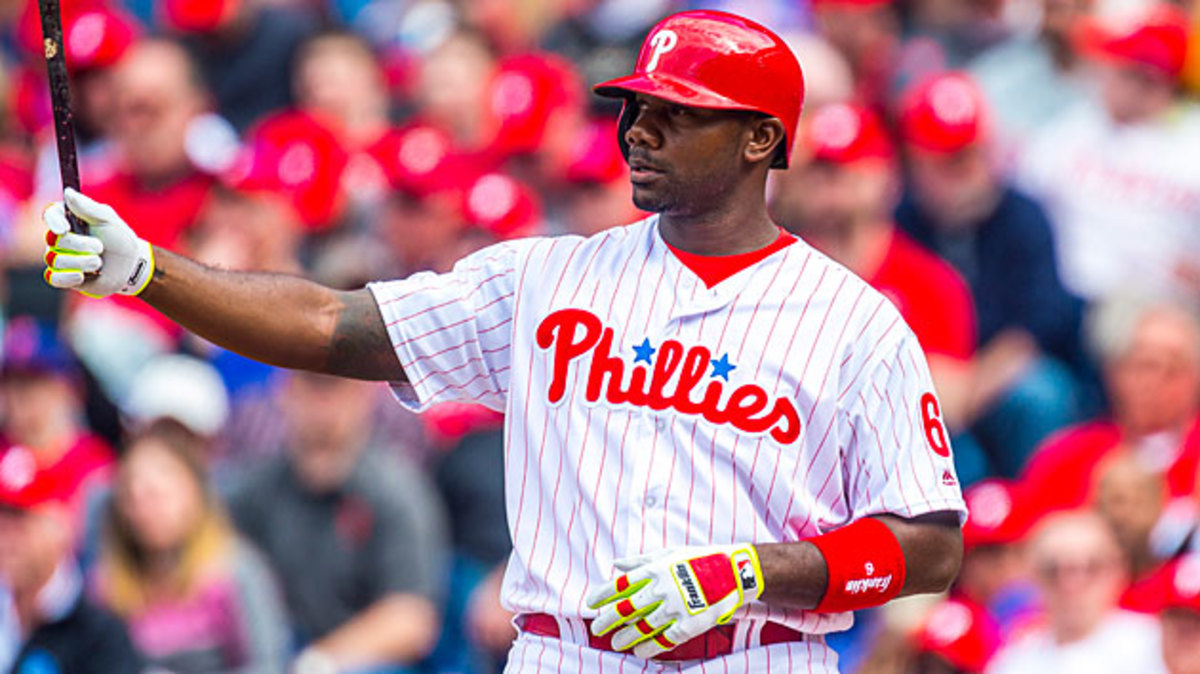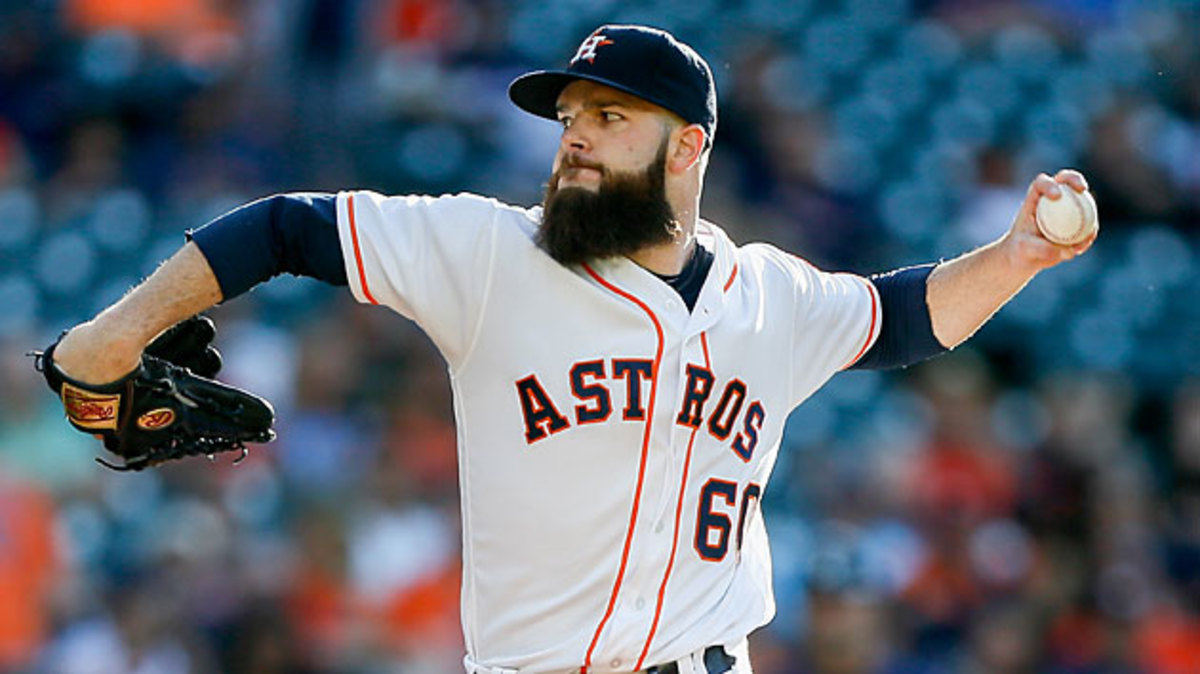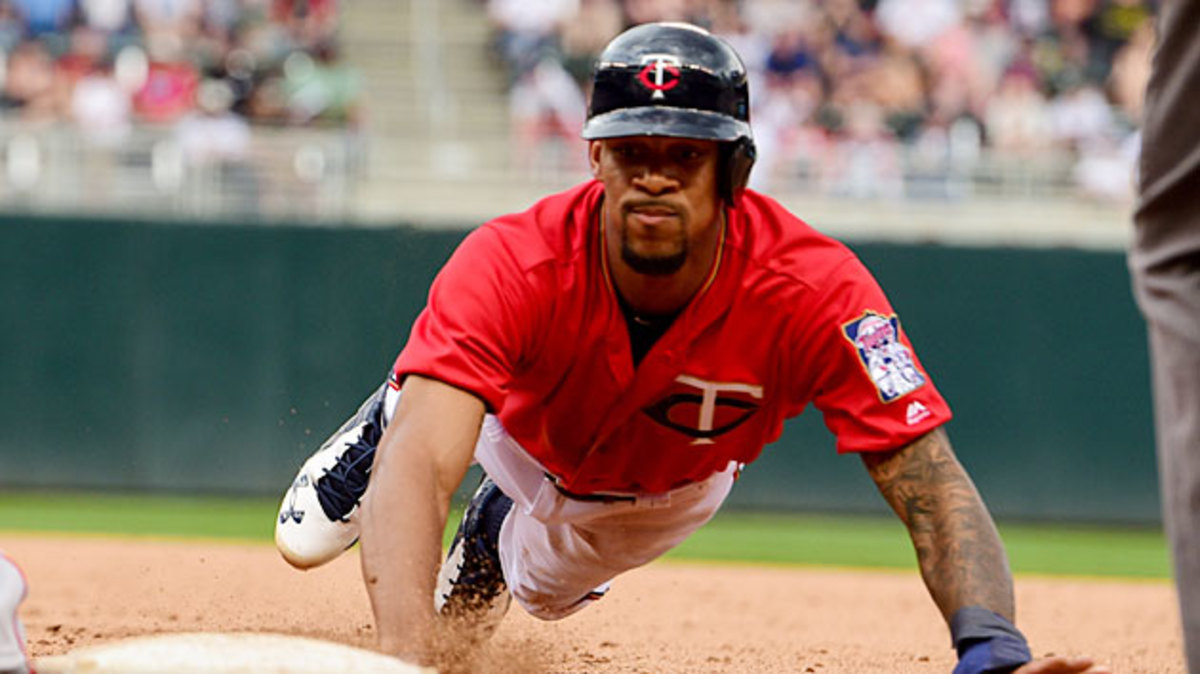What to expect from first-quarter surprises like Phillies, Astros, more

Get all of Cliff Corcoran’s columns as soon as they’re published. Download the new Sports Illustrated app (iOS or Android) and personalize your experience by following your favorite teams and SI writers.
The 2016 Major League Baseball season is roughly one quarter over the weekend begins. That is an alarming fact, because there are still several teams whose current position in the standings bears little resemblance to where they were expected to be when the season started. With that in mind, here’s a quick survey of eight of this season’s most surprising teams—four of which have overachieved relative to expectations and four that have done the opposite—with an eye toward what has been driving their unexpected performance and whether or not it will continue.
Note: Teams are ranked within the two categories in order of how surprising their performance has been. Third-order record uses the elements of run scoring (hits, walks, outs, etc.) to generate expected runs scored and allowed totals, then derives an expected winning percentage from those figures and adjusts the result for the team’s strength of schedule. Third-order wins and losses are rounded to the nearest game below.
Overachieving
Actual record: 24-17 (.585), 2nd in NL East, third-best record in NL
3rd order record: 17-24 (.423)
What’s gone right? The Phillies’ pitching has been better than expected thanks to the emergence of genuine prospects Vince Velasquez, 24, and Aaron Nola, 23, in the rotation and to a back-end-of the bullpen that has coalesced around closer Jeanmar Gomez and set-up men Hector Neris and David Hernandez. A significant improvement in team defense has also aided Philadelphia's run prevention; the club has gone from ranking 28th in the majors in park-adjusted defensive efficiency last year to 10th this year. That strong bullpen has helped the Phillies to a 14-3 record in one-run games and a perfect 4-0 record in extra innings. A soft schedule has also helped, as Philadelphia has yet to play the Cubs, Giants, Pirates or Dodgers.
Will it last? No. Every indication is that the Phillies are due for a major correction. Their offense is the second-worst in baseball, besting only that of the Braves, and they have been outscored by 28 runs on the season. First baseman Ryan Howard (below) has been particularly bad, with a .168 batting average and a .236 on-base percentage. Their third-order record suggests they have actually been the fifth-worst team in the NL this season. What’s propping them up is that lop-sided record in one-run games, but one-run records tend to trend toward .500 as the sample increases. Make Philadelphia 9-8 in its 17 one-run games (which represent 41% of the team's games to this point, by the way) and it would be be 19-22 on the season. The Phillies may not challenge Atlanta for the top pick in next year’s draft, but they should finish the season well below .500, as expected.

Actual record: 24-15 (.615), 1st AL East, best record in AL, second-best record in baseball
3rd order record: 22-17 (.558)
What’s gone right? Playing five games against the Twins hasn’t hurt. The Orioles have thus far swept their season series against Minnesota and gone 19-15 against everyone else. That 19-15 record works out to a .558 winning percentage, which happens to be an exact match for their third-order winning percentage. Still, credit Baltimore for capitalizing on its opportunities against the Twins, something the Indians and Angels (combined 2-7 against Minnesota) have failed to do. The 2016 Orioles have hewn closely to their formula in recent years of hitting a ton of home runs (57, second most in the majors) and getting great relief pitching (2.56 bullpen ERA, also second in the majors). Rebounds from would-be ace Chris Tillman in the rotation and off-season addition Mark Trumbo in the lineup, plus Manny Machado’s continued maturation into one of the best players in the game have helped, as well.
Will it last? Baltimore made the postseason in 2012 and '14 with similarly constructed teams, and it certainly seems capable of challenging for a wild-card berth, especially if five-time All-Star outfielder Adam Jones (91 OPS+) returns to his usual level (109 career mark). Still, expect the Orioles to fall out of first place in the AL East. As things stand, they are effectively tied with the Red Sox (who have a lower winning percentage by virtue of having both won and lost one more game), and Boston's imposing offense (first in the AL in runs, hits, batting average, on-base percentage and slugging) makes it look like the far better team.
Actual record: 23-17 (.575), 1st in AL West
3rd order record: 23-17 (.574)
What’s gone right? New general manager Jerry Dipoto completely overhauled Seattle's roster over the offseason, placing an overdue emphasis on balance and fielding. Leonys Martin has been a particularly successful addition in centerfield, playing spectacular defense and experiencing a rebound at the plate thanks to an unexpected power surge. Add in the elite talent left over from last year’s roster (specifically Robinson Cano, Nelson Cruz, Kyle Seager, Felix Hernandez and Taijuan Walker) and it's easy to see why the Mariners have become the pennant contender many thought they were going to be a year ago. After ranking 18th in park-adjusted defensive efficiency in 2015, Seattle enters the weekend No. 3 this year. The Mariners also have a new-found status as road warriors, going 15-7 away from Safeco Field, the second-best record in the majors behind that of the Cubs.
Will it last? Barring injury, yes. Notice how Seattle's actual and third-order records above are near-exact matches. The Mariners’ bullpen may be overachieving, but the improvement in the defense is real, as are the performances the team has received thus far from the five star players listed above. Look for Dipoto to make a well-targeted move at the non-waiver trading deadline and for Seattle to be in the thick of the AL West race down to the wire.
Actual record: 25-16 (.610), 1st in AL Central, tied for second-best record in AL and third-best record in baseball
3rd order record: 24-17 (.584)
How White Sox ace Chris Sale learned to do more (and be better) with less
What’s gone right? The White Sox are another team that made big off-season moves that have paid off in the regular season. They have gone from having the third-worst offense in baseball in 2015 to being slightly-above average in '16 and from fourth-worst in team defense (as measured by park-adjusted defensive efficiency) last year to fifth-best. The overhaul of their infield—adding third baseman Todd Frazier, second baseman Brett Lawrie and shortstop Jimmy Rollins—has helped on both fronts. The surprise retirement of designated hitter Adam LaRoche in March has indeed resulted in an upgrade in the outfield defense as well, with the team shifting Avisail Garcia to DH, moving Adam Eaton from centerfield to right (where he has emerged as the best defender in baseball, according to the early-season metrics) and inserting Austin Jackson in center. A rebound from leftfielder Melky Cabrera in his second season in Chicago has been important, as well.
That improved defense has helped Chris Sale and Jose Quintana emerge as the two best pitchers in the American League, as measured by ERA, in the early going and has contributed to an outstanding performance by the bullpen, which boasts the third-best relief ERA in the AL thus far (2.80, behind only those of the Orioles and Royals).
Will it last? The White Sox have benefited from sweeping six games against the Twins, but unlike the Orioles, they have many more of those remaining on their schedule. They also just experienced a bit of correction, going 2-6 in their last eight games, but with none of the losses coming by more than two runs. There’s not much in Chicago's performance thus far that suggest this team is a fluke, and Jose Abreu hasn’t even started hitting yet. With most of their division underperforming expectations (two prominent examples can be found below), the White Sox appear to be in this for the long haul, though their schedule over the remainder of the month could tells us more; they play their first seven games of the season against the Royals and four against the second-place Indians.
Underachieving
Actual record: 17-25 (.405), last in AL West, second-worst record in AL
3rd order record: 20-22 (.467)
What’s gone wrong? The Astros’ biggest problem so far has been the performance of their starting rotation. Only the Brewers, Rockies and A’s have had a worse rotation ERA than Houston's 4.97 mark through the first quarter of the season. Ace Dallas Keuchel (below) has appeared winded from his AL Cy Young-winning campaign of a year ago, showing declines in velocity, control and effectiveness. Sophomore Lance McCullers missed the first month and a half with a shoulder injury, then was lit up in his return against the Red Sox last Friday. Even rookie Chris Devenski, the one encouraging development in the Astros’ rotation this season, got torched in his last outing (2 IP, 6 R in Boston). A dramatic decline in defensive efficiency has accompanied those rotation struggles, though given the lack of turnover in Houston's lineup, one is tempted to blame that more on the pitchers getting hit hard than on some sudden collective decline in the performance of the fielders.
Beyond the rotation, the team’s big trade acquisitions have been awful. Brought over from Philadelphia to be their ace closer, Ken Giles not only lost that job in camp, but gave up 12 runs in his first 11 2/3 innings as an Astro. Centerfielder Carlos Gomez, acquired from Milwaukee last July, has been even worse, hitting .182/.238/.248 before landing on the disabled list with a bruised rib cage earlier this week.

Will it last? There are some indications it already hasn’t. Houston was the last team to win consecutive games this season, not doing so until taking the final two games of a series against the Twins on May 3 and 4. Dating back to those two games, however, the Astros are 9-7 and have won series against the White Sox and Indians and split a four-game set with Seattle. Over that span, they have outscored their opponents 84-72. Over their last dozen games against teams that don’t own the best offense in baseball (read: the Red Sox), the 'Stros have allowed just 3.25 runs per game. Again, those opponents include two of the first-place teams discussed above and second-place Cleveland.
Keuchel has two quality starts in his last three turns (again, the exception coming against Boston) and has regained some of his velocity. McCullers will get another chance to reboot his season Friday night at home against the Rangers. Meanwhile, prospect Joe Musgrove could force his way into the major league rotation in short order after having excelled in two starts since an early-May promotion to Triple A.
The trouble is that Houston may have dug itself too big a hole by starting the season 7-17, a near inverse of their 18-7 start a year ago. To get to the 86 wins that allowed them to just barely squeak into the playoffs last year, they’d have go to 69-51 (.575) over the remainder of the season.
Actual record: 20-23 (.465), 4th in AL East
3rd order record: 22-21 (.521)
The 30: What's luck got to do with this week's MLB power rankings?
What’s gone wrong? A year ago the Blue Jays had a historically great offense. That lineup is back largely intact, yet Toronto has struggled to score runs. Catcher and second base have been black holes thus far, contributing .170/.239/.197 and .223/.263/.318 lines, respectively. Shortstop Troy Tulowitzki is showing his usual power and patience, but he can’t buy a hit on a ball in play, with a .214 BABIP and .196 batting average. Drops in batting average have also pulled down the production of centerfielder Kevin Pillar and the lineup’s big three: Josh Donaldson, Jose Bautista and Edwin Encarnacion. Only a strong return from leftfielder Michael Saunders and a surge from first baseman Justin Smoak have kept the Blue Jays' offense from an even more dramatic drop in production.
Will it last? No. Batting average is erratic by nature and batting averages on balls in play typically trend toward league average. As a team, Toronto has hit .280 on balls in play. The league as a whole has hit .297 and last year the Jays hit .298. There is an obvious correction coming there. Indeed, Tulowitzki has already experienced some, hitting .303/.351/.667 over his last nine games with a .292 BABIP. The team could also activate sophomore Devon Travis to fill the second-base hole as early as this weekend (he has been raking on his minor league rehab assignment, which moved to Triple A on Thursday). Travis, you may recall, was an early Rookie of the Year candidate last year before a shoulder injury ended his season and ultimately required surgery.
What’s more, even what the Blue Jays have done thus far has translated to winning baseball, per third-order record. Blame a 4-10 mark in one-run games for some of their underperformance on that front, another statistic that suggests a positive correction to come. Unlike the Astros, Toronto hasn't dug a huge hole, it has simply underperformed. That offense will find its groove, possibly in short order, and the Blue Jays should be right back in the thick of the AL East race.
Actual record: 20-20 (.500), 3rd in AL Central
3rd order record: 17-23 (.423)
What’s gone wrong? As with their ALCS opponents from a year ago, the Royals have had trouble scoring this year, besting only the Twins, Padres, Phillies and Braves with 3.6 runs scored per game. Among their most frequent starters at each of the nine positions, only first baseman Eric Hosmer and third baseman Mike Moustakas have posted OPS+ figures above league average thus far, and Moustakas has been on the disabled list with a fractured thumb for the last two weeks. Designated hitter Kendrys Morales is suffering from a Blue Jays-like BABIP issue, hitting just .195 due to a .211 BABIP, but disappointing showings from stars Lorenzo Cain and Alex Gordon have no such easy answers, the rightfield platoon has not yet proved as effective as expected and the middle infield has remained an offensive sinkhole.
As their third-order record above suggests, Kansas City has been even worse than its actual record suggests. Since April 25, the team has gone 8-14 (.364) and been shut out four times. Only the Padres have been blanked more times on the entire season.
Will it last? The good news is that Moustakas could return this weekend. Morales should experience a positive correction, and the injuries that sent starters Chris Young and Kris Medlen to the disabled list last week might actually have improved the starting rotation given that those two were a combined 2-8 with a 7.15 ERA over 13 starts. Danny Duffy and Dillon Gee, a pair of experienced starters who had been pitching well out of the bullpen, have assumed those rotation spots.
Beyond that, however, the Royals look fairly ordinary. They're not as bad as their .423 third-order winning percentage suggests, but they might finish closer to their current .500 record than was expected before the season and miss the playoffs for the first time since 2013.

Actual record: 10-30 (.250), last in AL Central, tied for worst record in baseball
3rd order record: 13-27 (.334)
What’s gone wrong? The Twins can’t hit, pitch or field like a major league team. They are dead last in the American League in runs scored per game (3.58) and dead last in the American League in both runs allowed per game (5.28) and park-adjusted defensive efficiency. Centerfield prospect Byron Buxton (below) played his way back to Triple A before April was over. Their outfielders have collectively hit just .212/.265/.348. Their catchers have hit .199/.250/.301. Their rotation has a 4.97 ERA. Their bullpen has a 4.81 ERA (third-worst in baseball). Their closer, Glen Perkins, hit the disabled list after just two innings and won’t be back until June. Their top pitching prospect, Jose Berrios, has a 10.20 ERA after four major league starts and has rejoined Buxton in Triple A. In a word: everything.
• Subscribe to get the best of Sports Illustrated delivered right to your inbox
Will it last? Minnesotawon’t be this bad all season, and it won't surpass the 1962 Mets for worst modern-era record by going 41-121, which is what the team's current winning percentage projects to. Miguel Sano has hit .245/.333/.481 since smacking his first home run of the season on April 18. Korean import Byung-ho Park has hit .262/.337/.583 over the same span. Second baseman Brian Dozier has been undermined by a .239 BABIP should experience positive correction going forward. Third baseman Trevor Plouffe missed two weeks with an intercostal strain and should contribute more over the remainder of the season. Those four and Joe Mauer, who started hot but has slumped of late, should keep the offense afloat, and young pitchers Berrios and Alex Meyer, who is attempting a return to starting but also battling shoulder fatigue, may yet make contributions at the major league level.
Still, it’s clear now just how much of a fluke Minnesota's 83-wins were last year, when it was outscored by its opponents on the season, and just how poorly constructed this team is, regardless of the talent being produced by the farm system. The Twins would have to go 71-51 (.582) the rest of the way just to finish .500. Even that seems out of reach at this point.
